Introduction
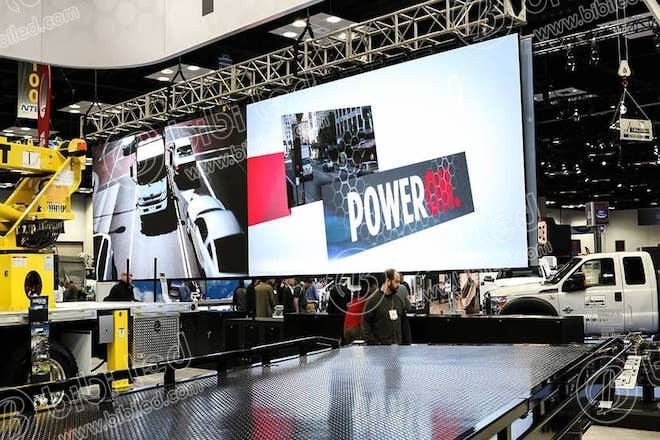
When you step into the exhibition hall, have you ever been deeply attracted by those dazzling LED displays?
They not only convey rich information but also make every exhibition a feast of vision and soul with their unique charm. But faced with a wide range of LED displays, how to choose the one that best suits your exhibition hall?
Don’t worry; this article is your savior! We will take you to deeply understand the special needs of the exhibition hall environment for the display, reveal the characteristics and advantages of different LED displays, and provide you with a concise purchase guide through actual cases and cost-benefit analysis.
Whether you are a novice or a senior operator of the exhibition hall, you can find the answer that suits you here to make your exhibition hall display more colorful!
Next, let’s embark on this journey to find the perfect LED display together!
1. Exhibition hall environment analysis
1). Light conditions: Brightness is the key
- The impact of natural light and artificial lighting
Imagine that when you walk into an exhibition hall, if it is sunny outside, but the display is dim, do you have to get closer to see it clearly? This is the impact of natural light on the brightness of the display.
Similarly, if the lights in the exhibition hall are bright, the display screen must also be bright enough to let you see clearly at a glance. Therefore, when choosing a display screen, you have to see if it is bright enough and whether it can remain clear even under strong light.
- The necessity of high-brightness
A high-brightness display screen is like a bright lamp that can still illuminate your sight in a bright environment. It not only allows you to read the content easily in a sunny exhibition hall but also reduces reflections and glare, making your eyes less tired.
2). Space layout: The art of size and distance
- Matching the size of the exhibition hall with the size of the display screen
If the exhibition hall is large, the display screen must be larger so that it can look grand and display more content. But it is not the bigger, the better; it depends on how far you stand to see.
If you stand close, a small screen is enough; if you stand far, a large screen can be seen clearly. Therefore, you have to choose a suitable size according to the size of the exhibition hall and your viewing distance.
- The relationship between audience distance and resolution and pixel density
The resolution is how many small dots (pixels) there are on the display screen. The more dots, the clearer the picture. The pixel density is how dense these small dots are. The higher the density, the more delicate the picture.
If you stand close, you have to choose a high pixel density so that the picture is clear enough. If you stand farther away, a higher resolution is enough.
3). Design style: Harmony of appearance and color
- Coordination of exhibition hall style and display appearance
If the exhibition hall is simple, the display screen cannot be too fancy. The frame must be simple, the color must match, and the material must be consistent.
Just like you wear clothes, it must be coordinated as a whole to look good. You must also pay attention to the installation method, which must be stable and not affect the appearance.
- Fusion of display screen color and exhibition hall color
The color theme of the exhibition hall is like its mood. The cold color looks full of technology, while the warm color is warm and comfortable. The color of the display screen must keep up with this rhythm and cannot be out of tune.
For example, in the exhibition hall with cold colors, the display screen must also be cooler; in the warm color, it must be warmer. In this way, the entire exhibition hall looks harmonious and unified.
In general, choosing an LED display screen is like choosing clothes. You have to choose it according to your figure (exhibition hall environment).
Lighting conditions, spatial layout, and design style must all be taken into consideration. Only in this way can you pick the one that suits you best and make your exhibition hall more outstanding!
2. Introduction to the types of LED displays suitable for exhibition halls
Choosing the right LED display in the exhibition hall is like putting on a coat that fits and attracts your exhibition.
Different types of LED displays, like different styles of clothes, each have their own unique charm and applicable occasions. Below, we will take a detailed look at four common types of LED displays suitable for exhibition halls, as well as their characteristics and applicable scenarios, to help you make a choice easily.
1). Small-pitch LED display: Delicate and clear, suitable for close-up appreciation
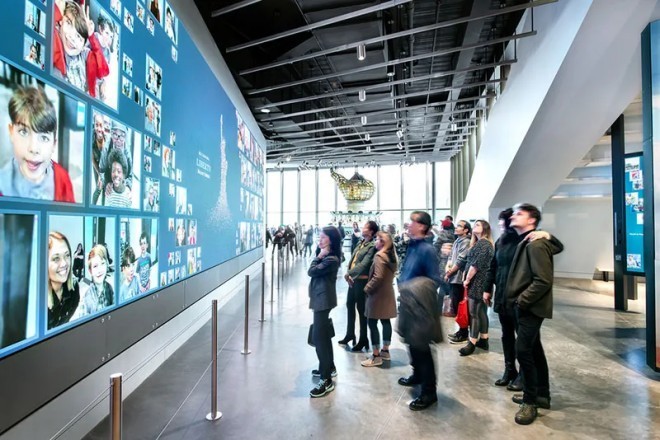
1.1). Feature description:
High definition: Imagine that you are standing in front of a huge oil painting and can clearly see the details of every stroke. The small-pitch LED display is like this oil painting. The distance between its pixels is very small, so it can present an extremely delicate and clear picture.
High contrast: Contrast is like the “layering” of the picture. High contrast means that the picture is clearly black and white, and the colors are more vivid and three-dimensional. Just like the blue sky and white clouds you see in the sun, so clear and three-dimensional.
Good viewing effect at close range: If you stand very close to look at a painting, you will find that the details on the painting are richer. Similarly, when viewed at close range, the small-pitch LED display can still maintain the clarity and delicacy of the picture, making you feel as if you are in the picture.
1.2). Applicable scenarios:
High-end exhibition halls: For example, jewelry exhibitions, art exhibitions, etc., need to display fine products or artworks, and small-pitch LED displays can perfectly present every detail of the product.
Artwork display: When you want to display a beautiful painting or sculpture, the small-pitch LED display can be used as a background or auxiliary display tool to enhance the appeal of the artwork.
Detail display area: In areas where product details or process flows need to be displayed, the small-pitch LED display can clearly display every step and detail, allowing the audience to understand the product more deeply.
2). Rental LED display: Flexible and convenient, suitable for temporary exhibitions
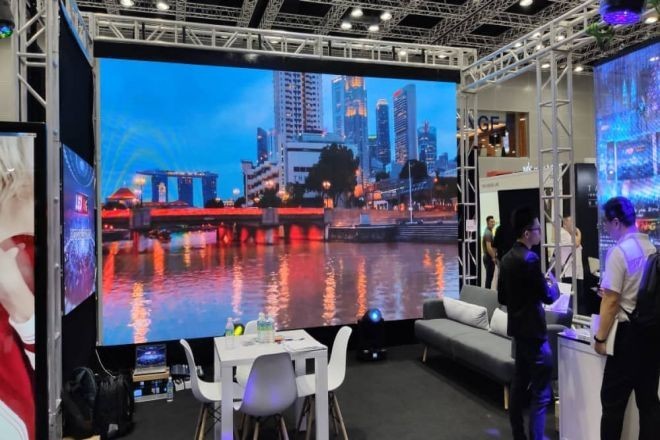
2.1). Features:
Lightweight and easy to install: The rental LED display is like a “big box” that can be disassembled at any time. It is light in weight, compact in structure, and very simple and quick to install.
Easy to transport and reuse: Due to the modular design, the rental LED display can be easily disassembled, transported, and stored. Moreover, it has a long service life and can be reused many times, which is very economical.
2.2). Applicable scenarios:
Temporary exhibitions: For short-term exhibitions such as cultural festivals, art festivals, product launches, etc., rental LED screens can flexibly respond to various temporary needs.
Event exhibitions: In various large-scale events and exhibitions, rental LED screens can be used as an important tool for information display and advertising playback to attract the attention of the audience.
Multi-venue tour exhibitions: If your exhibition needs to be toured in multiple venues, the portability and reusability of rental LED screens will be your best choice.
3). Transparent LED screen: Unlimited creativity, enhances the sense of transparency in space
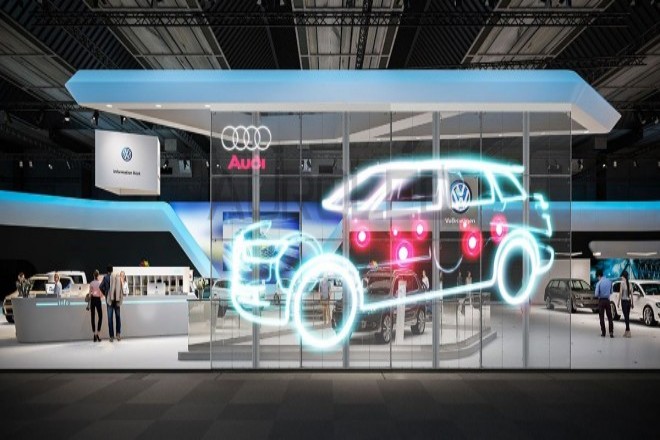
3.1). Features:
High transparency: The transparent LED screen is like a piece of transparent glass, but it can play videos and images. Its grid-like structure allows light to penetrate without affecting the transparency of the space.
Good creative display effect: The transparent LED screen can be combined with the background environment for creative display, such as combining videos with physical exhibits to create amazing visual effects.
3.2). Applicable scenarios:
Window display: In retail stores or brand stores, transparent LED display screens can be used as part of the window display to attract customers’ attention and enhance brand image.
Interactive experience area of science and technology museums: In science and technology museums, transparent LED display screens can be used as part of the interactive experience, allowing the audience to learn scientific knowledge in the interaction.
Retail stores: Installing transparent LED display screens at key locations in the store can dynamically display product advertisements, promotional information or brand stories, and enhance customers’ purchasing desire and brand awareness.
4). Flexible/curved LED display screens: Diverse forms, enhanced visual impact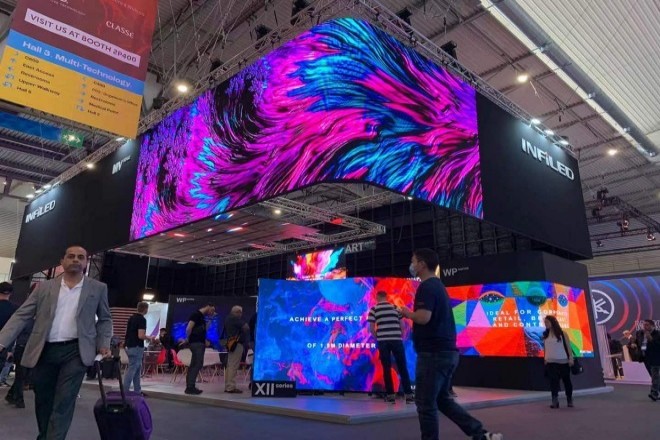
4.1). Feature description:
Flexible form: Flexible/curved LED display screens are like a piece of “cloth” that can be bent at will. It can be customized into various shapes and sizes according to your needs.
Customizable shape according to space: In the exhibition hall, you may need a display screen that can fit the wall or column. Flexible/curved LED display screens can be customized according to your needs and perfectly integrated into the space.
Enhance visual impact: Unique forms and visual effects can attract the attention of the audience and make your exhibition more eye-catching.
4.2). Applicable scenarios:
Creative exhibition halls: For example, exhibition halls such as science and technology museums and art galleries that need to display creativity and design concepts, flexible/curved LED displays can become the highlight of the display.
Theme parks: In theme parks, flexible/curved LED displays can be used as decoration or information display tools to increase the interactivity and fun of visitors.
Future technology display area: In the future technology display area, flexible/curved LED displays can be used as an important tool to display future technology products or concepts, creating a sci-fi and avant-garde display atmosphere.
3. Consideration of key performance indicators of LED display screens
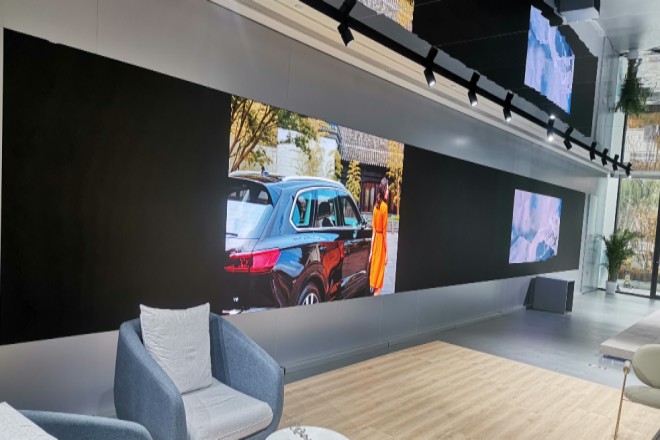
When selecting LED display screens, key performance indicators are important factors to ensure the display effect and quality. The following is a detailed consideration of the four key performance indicators of resolution and pixel density, brightness and contrast, refresh rate, and viewing angle:
1). Resolution and pixel density
- Concept explanation:
Resolution refers to the number of horizontal and vertical pixels that the display screen can display. Common resolutions include 720p, 1080p, 4K, etc. The higher the resolution, the more pixels the display screen can display and the richer the image details.
Pixel density refers to the number of pixels that a display can display in a specific area, and the unit is generally pixels per inch (PPI). The higher the pixel density, the richer the details displayed in the same area and the clearer and sharper the image.
- Impact on image clarity:
Resolution and pixel density directly affect the clarity of the image. Displays with high resolution and high pixel density can present more details and richer colors, making the image more realistic and vivid.
In the exhibition hall environment, high-resolution and high-pixel-density LED displays can ensure that viewers can see clear and delicate images even when watching at close range.
2). Brightness and contrast
- Brightness:
Concept: Brightness refers to the intensity of light emitted by the display.
Requirements in different light environments: In bright environments, such as outdoors or in a well-lit exhibition hall, a high-brightness display needs to be selected to ensure that the image is clearly visible. In darker environments, a display with moderate brightness can be selected to save energy and reduce glare.
- Contrast:
Concept: Contrast refers to the difference between the brightest and darkest parts that a display can display. High contrast can present more details and deeper blacks, making the image more three-dimensional and vivid.
Importance of color level performance: High contrast can enhance the color level and three-dimensional sense, making the image fuller and more realistic. In the exhibition hall environment, high-contrast display screens can ensure that the audience can see clear and vivid images under various lighting conditions.
3). Refresh rate
Concept: Refresh rate refers to the number of times the display screen is repeatedly displayed by the display screen per second, and the unit is Hertz (Hz).
Impact on the smoothness of dynamic images: The higher the refresh rate, the more stable and smooth the picture display, and the less visual flicker. In the exhibition hall environment, especially when displaying dynamic content (such as videos, animations, etc.), high refresh rate LED displays can provide a smoother and more natural viewing experience.
4). Viewing angle
Concept: Viewing angle refers to the maximum angle range that the observer can see the content on the screen when observing from the front.
Ensure that the audience can see clearly from all angles: In the exhibition hall environment, the audience may view the display screen from different angles. Therefore, it is necessary to select an LED display screen with a larger viewing angle to ensure that the audience can see clear and distortion-free images at all angles.
Generally speaking, the viewing angle of the LED display screen should be at least 120 degrees or more to ensure a good viewing effect.
Conclusion
Through in-depth understanding and comparative analysis, we can select the most cost-effective and most effective LED display for the exhibition hall.
It is worth noting that with the continuous advancement of technology and the continuous development of the market, the performance and price of LED displays are also constantly changing.
Therefore, when choosing a display, we should not only pay attention to the current market situation but also focus on future development trends to ensure that the selected display can meet the needs of the long-term operation of the exhibition hall.
Finally, if you want to know more about LED displays, please get in touch with us.
